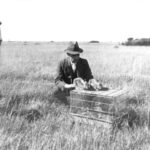For decades, climate scientists have highlighted concerns about climate change caused by greenhouse gasses emitted by humans (through fossil fuel use as well as refrigerants). While reducing greenhouse gas emissions would solve the crisis, there is a lack of political will, particularly in the United States, which prevents significant progress towards meeting goals set by the United Nations Framework Convention on Climate Change (UNFCCC). As deadlines are missed and the crisis increases in urgency, alternative solutions like geoengineering (the intentional large-scale manipulation of the climate) have gained traction in science fiction like the movie Interstellar or novel The Ministry of the Future. But how realistic are these solutions?
While many of the geoengineering options for climate change are still being discussed, we can look to history for examples of how similar large-scale projects turned out. Today’s proposals for correcting our impacts on the climate are dramatic, involving spraying chemicals high in the atmosphere to deflect the sun’s rays or cultivating seas of algae to offset carbon emissions. In years past, they involved planting trees and building canals to combat the droughts and dust storms in the United States and the Soviet Union during the first half of the 20th century. In the US, the dust bowl was a period of severe dust storms spanning much of the plains region, caused by both severe droughts and poor farming practices. Between 1930 and 1940, the top soil of this region was blown into large storms, “black blizzards”, which blocked out the sun and piled dirt into drifts (occasionally bringing the soil all the way to the east coast). This environmental catastrophe led to the mass exodus of 400,000 people.
Works Projects Administration (WPA) poster advertising the Great Plains Shelterbelt project (also referred to as the Prairie States Forestry Project) CC 2.0
In an effort to address the crisis, Franklin D. Roosevelt approved the Great Plains Shelterbelt project. Between 1935-1942, nearly 223 million trees were planted in 18,599 miles of field to establish windbreaks across the plains states. These rows of trees, known as shelterbelts, helped reduce wind velocity and lessened the evaporation of moisture from the soil. As many of us have experienced during a nice cool hike in a forest, trees both partially block sunlight, keeping the ground cooler (thereby reducing evaporation) and slow the wind. As a result, shelterbelts helped reduce erosion and increase production of crops on sheltered fields by an average of 12-15%. While many shelterbelts have since been replaced by smaller windbreaks, the same principle is still used to this day to protect farmland and prevent future catastrophes like the dust bowl of the 1930s.
Much like the US experienced in the 1930s, during the 1940s, the USSR went through a widespread drought and famine. In response, Stalin launched the Great Plan for the Transformation of Nature. Much like the US, this included the installation of a large network of shelterbelts along the steppes of the southern USSR. Unlike the US, they leveraged a “nest method” to plant the trees in high density clusters advocated for by Trofim Lysenko and a series of canals to increase irrigation to the area. While the tree planting method was largely ineffective, the real tragedy came from the irrigation canals. The USSR fed these canals using the Anu Darya and Syr Darya rivers, which in turn fed the fourth largest lake in the world, the Aral Sea. These canals were inefficient and led to increased evaporation, and while soviet scientists attempted to warn their government of the negative drawbacks to the project, they were ignored. While the Aral Sea was stable until the 1960s, later expansions to the canal system led to a dramatic decline in the lake, as much as 20-35 inches per year. By 1998, the lake had shrunk in size by 11,076 square miles, split into two bodies of water, and its salinity increased to higher than the dead sea. The ecosystem, which once contributed one sixth of the Soviet Union’s entire fish catch, has since collapsed. Ships have been left stranded on the shore, most species were unable to survive the high salinity, and the collapse of the body of water has led to dust storms and changes to the climate and wind patterns in the region.
The Aral Sea 1989 (left) to 2008 (right). CC 2.0
We are entering an increasingly uncertain future as a result of the impacts of climate change are felt throughout the world. Wildfires are becoming more frequent in the US, hurricanes and cyclones are popping up with greater vigor and more often in the south, and heatwaves are increasingly reaching dangerous levels. Reducing greenhouse emissions and mitigating future climate change acceleration is a top priority, but we may need to brainstorm additional solutions to help reduce the damage we have already caused. As we enter this new crisis, we should remember the last century’s crises and the great geoengineering projects that attempted to rectify them. As we look to use sulfate aerosols (or other novel ideas still in the works) to slow the worst impacts of climate change, it’s important to maintain a vigorous scientific debate on the issue. While many factors led to the Aral Sea catastrophe, a key component was the politicization of scientific discourse, which privileged scientists with ideologically convenient theories (like Lysenko) and prevented other scientists’ calls for a stop to the project. Hopefully we can repeat the successes of the Great Plains Shelterbelt project without duplicating the ecosystem collapse wrought by the Great Plan for the Transformation of Nature.
About the Author
Guppy is a third-year bioinformatics Ph.D. student. They have a master's degree in statistics from NC State University, an undergraduate degree in mathematics from Clemson University, and spent a few years working for TIAA as a data scientist before heading to UGA. Their research focuses on studying the evolution and spread of SARS-CoV-2 and highly pathogenic avian influenza using statistical and computational methods. Outside of the lab, Guppy can be found bouldering at Active Climbing, reading science fiction and history, going on hikes with their puppy, Zoya, roasting and drinking coffee, or playing tabletop role-playing games like Dungeons and Dragons.
-
Guppy Stotthttps://athensscienceobserver.com/author/guppy-stott/February 29, 2024
-
Guppy Stotthttps://athensscienceobserver.com/author/guppy-stott/
-
Guppy Stotthttps://athensscienceobserver.com/author/guppy-stott/November 16, 2021








